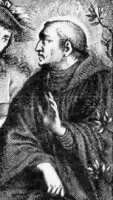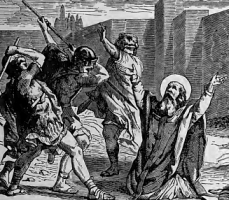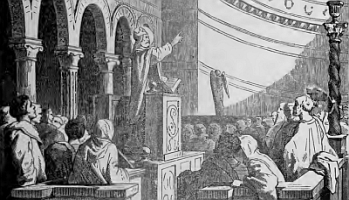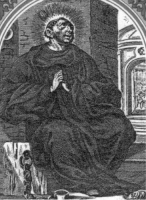Saint Peter Damian
புனிதர் பீட்டர் டமியான்
கர்தினால்-ஆயர், மறைவல்லுநர்:
பிறப்பு: கி.பி. 1007
ரவேன்னா, வடக்கு இத்தாலியின் எமிலியா-ரொமாக்னா பிராந்தியம்
இறப்பு: ஃபெப்ரவரி 22, 1072
ஃபயேன்சா, ரவேன்னா, வடக்கு இத்தாலியின் எமிலியா-ரொமாக்னா பிராந்தியம்
ஏற்கும் சமயம்:
ரோமன் கத்தோலிக்க திருச்சபை
நினைவுத் திருவிழா: ஃபெப்ரவரி 21
புனிதர் பீட்டர் டமியான், ஒரு சீர்திருத்த டொமினிக்கன் துறவியும், திருத்தந்தை ஒன்பதாம் லியோ (Pope Leo IX) காலத்தில் ரோமின் புறநகரின் “ஓஸ்தி” (Ostia) மறைமாவட்ட கர்தினால்-ஆயருமாவார். “டான்டே” (Dante) எனும் பிரபல இத்தாலிய கவிஞர், இவரை “புனிதர் அசிசியின் பிரான்சிஸு’க்கு” (Saint Francis of Assisi) முன்னோடியாகக் கருதி தனது புனைவு நூலில் இவர் விண்ணகத்தில் மிக உயரிய இடத்தில் இருப்பதாக கவிதை புனைந்துள்ளார். இவர், 1823ம் ஆண்டு, திருச்சபையின் மறைவல்லுநர் என அறிவிக்கப்பட்டார்.
கி.பி. சுமார் 1007ம் ஆண்டு, வடக்கு இத்தாலியின் எமிலியா-ரொமாக்னா பிராந்தியத்திலுள்ள ரவென்னா நகரிலுள்ள பிரபல ஆனால் ஏழைக் குடும்பத்தில் கடைக்குட்டியாக பிறந்த இவர், சிறுவயதிலேயே அனாதரவானார். ஆரம்பத்தில் இவரை தத்தெடுத்த சகோதரர்களில் ஒருவரால் மிகவும் கொடுமைப் படுத்தப்பட்டார்.
சொந்த சகோதரர் புறக்கணித்ததால், ஏழ்மையிலிருந்து தப்பி, ரவென்னா (Archpriest of Ravenna) மறைமாவட்டத்தின் குருவாக இருந்த தமது இன்னொரு சகோதரரான “டமியானஸ்” (Damianus) என்பவரிடம் அடைக்கலம் புகுந்தார். அவர் பீட்டர் டமியானை நல்ல கல்விக் கூடங்களுக்கு அனுப்பி கல்வி கற்க செய்தார். அதன் காரணமாக, பீட்டர் ஒரு பேராசிரியராக உயர்ந்தார். அவர் மிகவும் ஒழுக்க சீலராக இருந்தார். கடுமையான உழைப்புடன், ஜெபிப்பதற்கென்று பல மணிநேரம் செலவிட்டார்.
விரைவிலேயே அவர் பேராசிரியர் பணியை விட முடிவு செய்ததுடன், அவேல்லானா'விலுள்ள ஃபோன்டே எனும் இடத்திலுள்ள புனித ரோமுவால்டின் வின் ஆசீர்வாதப்பர் சீர்திருத்த சபையில் (Benedictines of the reform of St. Romuald at Fonte Avellana) சேர்ந்து முழுநேர ஜெப வாழ்வில் இணைய முடிவு செய்தார். அங்கே இரண்டு துறவியர் இருந்தனர். பீட்டர் உறக்கத்தை குறைத்துக் கொண்டு, அதிக நேரம் ஜெபிப்பதில் மிகவும் ஆர்வமாயிருந்தார். அதன் காரணமாக, அவர் தூக்கமின்மை (Insomnia) நோயால் பாதிக்கப்பட்டார். அவர், தமது ஆரோக்கியத்திற்காக, ஜெபிக்காத வேளைகளில் திருவிவிலியம் படிப்பதில் செலவிட்டார்.
ஆசீர்வாதப்பர் சீர்திருத்த சபையின் மடாதிபதி தமது மரணத்தின்போது, பீட்டரை தமது மடத்துக்கு தலைவராக நியமித்தார். பீட்டர், மேலும் ஐந்து துறவியரை அங்கு சேர்த்தார். அவர், தமது சகோதரர்களையும் தனிமை மற்றும் ஜெப வாழ்வுக்கு ஊக்கப்படுத்தினார்.
ரோமிலுள்ள இரண்டு ஆசிரமங்களுக்கும் அரசு அலுவகங்களுக்குமிடையே இருந்த பிரச்சனைகளை தீர்த்து வைத்தார்.
அவர் கடுமையாக உழைத்து, "தன் சுய நலனுக்காக கிறிஸ்தவ ஆலயங்களின் புனிதப் பொருள்களைப் பயன்படுத்தும்" (Simony) முறையை ஒழித்தார். தமது கத்தோலிக்க குருக்கள் கடின பிரம்மச்சரியத்தைக் கடைபிடிக்க ஊக்குவித்தார். மறைமாவட்ட குருமார்கள் ஒன்றாக வசிக்கவும், ஜெபம் மற்றும் மத காரியங்களில் ஈடுபடவும் வற்புறுத்தினார். பழமையான ஒழுக்கத்தை மீட்டார். வறுமை மீறல், தேவையற்ற பயணங்கள், மற்றும் சொகுசு வாழ்க்கை முறையைக் கண்டித்தார்.
அவர், 'பெசான்கான் ஆயரு'க்கு (Bishop of Besancon) எழுதிய ஒரு கடிதத்தில், அங்குள்ள தேவாலய அலுவலகத்தில் இறை பாடல் பாடுபவர்கள், பாடல் பாடுகையில் அமர்ந்திருந்ததாக குறை கூறினார்.
அவர், பல கடிதங்கள் எழுதியுள்ளார். அவற்றில் சுமார் 170 கடிதங்கள் நடப்பிலுள்ளன. நம்மிடையே இன்றும் அவர் எழுதிய சுமார் 53 மத சொற்பொழிவுகள், ஏழு உயிர்ப்புகள் மற்றும் சுயசரிதங்கள் உள்ளன.
அவர் தமது எழுத்துக்களில் கோட்பாடுகளைவிட, கதைகள் மற்றும் மேற்கோள்களுக்கு அதிக முக்கியத்துவம் தந்தார். அவர் எழுதிய வழிப்பாட்டு அலுவலக சந்தங்கள் லத்தீன் மொழியில் அவரது திறமைக்கு சான்றாகும்.
டான்டே அலிகியேரி, இவரை புனித அசிசியின் ஃபிரான்சிசுக்கு முன்னோடியாகக் கருதி, தனது புனைவு நூலில் இவர் விண்ணகத்தில் மிக உயரிய இடத்தில் இருப்பதாக கவிதை புனைந்துள்ளார்.
அவர், தம்மை ஒஸ்டியா மாகான கர்தினால்-ஆயர் (Cardinal-Bishop of Ostia) பதவிலிருந்து விடுவிக்குமாறு அடிக்கடி கேட்டுகொண்டார். இறுதியாக, இரண்டாம் அலெக்சாண்டர் (Alexander II) அவரை விடுவித்தார். பீட்டர் தமியான் மீண்டும் ஒரு துறவியாகியதில் பெரும் மகிழ்ச்சியடைந்தார். ஆனால், அவர் திருத்தந்தையின் தூதராக பணிபுரிய இப்போதும் அழைக்கப்பட்டார்.
ஒருமுறை, தனக்களிக்கப்பட்ட ஒரு பணியை முடித்துவிட்டு 'ரவேன்னா'விலிருந்து (Ravenna) திரும்புகையில் ஜூரத்தால் பாதிக்கப்பட்டார். துறவிகள் சூழ்ந்திருக்க, கி.பி. 1072ம் ஆண்டு, ஃபெப்ரவரி மாதம் 22ம் நாளன்று, அவர் உயிர் துறந்தார்.
புனிதர் பட்டம்:
இவரை கத்தோலிக்க திருச்சபையின் மறைவல்லுநர் என திருத்தந்தை பன்னிரண்டாம் லியோ (Pope Leo XII) கி.பி. 1823ம் ஆண்டில் அறிவித்தார். இவரின் நினைவுத் திருவிழா நாள் ஃபெப்ரவரி மாதம், 21ம் நாளாகும்.
இவருக்கு முறைப்படி புனிதர் பட்டமளிப்பு நிகழவில்லை என்பது குறிக்கத்தக்கது. இவரின் இறப்பு முதலே இவருக்கு மக்கள் வணக்கம் செலுத்தி வந்துள்ளனர். இவரது உடல் அடக்கம் செய்யப்பட்ட இடத்திலிருந்து ஆறு வெவ்வேறு இடங்களுக்கு மாற்றப்பட்டு தற்போது ஃபயேன்ஸா (Cathedral of Faenza) மறைமாவட்ட முதன்மைப் பேராலயத்தில் உள்ளது.
Also known as
Petrus Damiani
Profile
Youngest child in a large but impoverished family of local nobility. Orphaned young, Peter was sent to live with a brother who mistreated him and forced him to work as a swine-herd. A pious boy, Peter was eventually sent to live with another brother, Damian, a priest in Ravenna, Italy; Peter was so grateful that he took the name Damian. Well educated in Ravenna, in Faenza and in Parma Italy. Professor. He was known for his life of strict austerity.
Around 1035, Peter gave up teaching to retire from the world and become a Benedictine monk. His health suffered, especially when he tried to replace sleep with prayer. He was forced to spend time in recovery; he used it to study Scripture, and when he was healthy, he was assigned to teach his brother monks and then the public. Economus of Fonte-Avellana; prior of the house in 1043, a post in which he served for the rest of his life. He expanded the monastery, greatly improved its library, and founded sister hermitages in San Severino, Gamugno, Acerata, Murciana, San Salvatore, Sitria, and Ocri. Friend of the future Pope Saint Gregory VII.
Attended a synod in Rome in 1047, and encouraged Pope Gregory VI to support a revitalization of Church zeal and clerical discipline. Wrote Liber Gomorrhianus, which described the vices of priests, mainly in their concern with worldly matters, with money, and the evil of simony. Created cardinal-bishop of Ostia on 30 November 1057. Fought simony. Tried to restore primitive discipline among priests and religious who were becoming more and more worldly. Strongly opposed anti-pope Benedict X. Legate to Milan for Pope Nicholas II in 1059; worked there with Saint Ariald the Deacon and Saint Anselm of Lucca. Supported Pope Alexander II.
A prolific correspondent, he also wrote dozens of sermons, seven biographies (including a one of Saint Romuald), and poetry, including some of the best Latin of the time. He tried to retire to live as a simple monk, but was routinely recalled as papal legate, called upon to make peace between arguing monastic houses, clergymen, and government officials, etc. Declared a Doctor of the Church in 1828.
Born
1007 at Ravenna, Italy
Died
• 22 February 1072 of fever at Ravenna, Italy while surrounded by brother monks reciting the Divine Office
• immediately buried in the in the monastery church; there were concerns that others would try to obtain his relics
• cultus developed almost immediately after his death
• relics moved several times, and since 1898 has been in the Chapel of Saint Peter Damian in the catherdral of Faenza, Italy
Canonized
1823 by Pope Leo XII (cultus confirmation)
Patronage
Faenza, Italy
Saint Robert Southwell
Additional Memorials
• 25 October as one of the Forty Martyrs of England and Wales
• 29 October as one of the Martyrs of Douai
Profile
Raised in a piously Catholic family. Educated at Douai and at Paris, France. Joined the Jesuits in 1580. Prefect of studies in the English College at Rome, Italy. Ordained in 1584. Returned to England in 1586 to minister to covert Catholics, working with Henry Garnett. Chaplain to Ann Howard, wife of Saint Philip Howard, in 1589. Wrote a number of pamphlets on living a pious life. Arrested in 1595 for the crime of being a priest. Repeatedly tortured in hopes of learning the location of other priests. He was so badly treated in prison that his family petitioned for a quick trial, knowing that his certain death would be better than the conditions in which he was housed. He spent three years imprisoned in the Tower of London, and was tortured on the rack ten times; between abuses he studied the Bible and wrote poetry. He was finally tried and convicted for treason, having admitted that he administered the Sacraments. Martyr.
Born
1561 in Horsham Saint Faith, Norfolk, England
Died
• hanged, drawn and quartered on 21 February 1595 in Tyburn, London, England
• while hanging, he repeatedly made the sign of the cross
• onlookers tugged at his legs to help him die quicker
Canonized
25 October 1970 by Pope Paul VI
Blessed Noël Pinot
Also known as
Natalis, Natale
Profile
Ordained in 1771, he served for several years as assistant pastor at different parishes. Parish priest at Saint Aubin, Louroux-Beconnais, France in 1788, with a special ministry with the sick.
In the French Revolution, he was required to take an oath of loyalty to the new government, an oath that was opposed to Church principles. Noel refused, and was ordered to abandon his parish, to come no closer to it than eight miles for at least two years. He left, then returned in secret, and ministered clandestinely to his flock. Some of his brother priests took the civil oath, but Noel convinced several of them to renouce it, and return their loyalty to the Church.
In 1793, a counter-revolution began in western France; when these forces won some victories, Pinot returned to openly ministering to his flock. However, the forces of the Revolution began to win again, and Pinot became a wanted man. Captured by government soldiers while preparing for Mass, he was imprisoned for twelve days; sentenced to death for refusing to take the oath, and encouraging others to do so.
Born
19 December 1747 at Angers, Maine-et-Loire, France
Died
• guillotined on 21 February 1794 at Angers, Maine-et-Loire, France
• he wore his Mass vestments to execution, and died reciting the opening words of the Mass
Beatified
21 October 1926 by Pope Pius XI
Blessed Thomas Pormort
Also known as
Thomas Whitgift
Additional Memorial
• 22 November as one of the Martyrs of England, Scotland, and Wales
• 29 October as one of the Martyrs of Douai
Profile
Educated at Cambridge University. Studied at the seminary in Rheims, France in 1581, and then, beginning in 1582, in Rome, Italy. Ordained in 1587. Worked with Bishop Owen Lewis in the diocese of Cassano, Italy. Prefect of studies at the Swiss college in Milan, Italy on 25 April 1590. He returned to England, travelling under the name Whitgift, and was arrested on 25 July 1591 in London for the crime of being a priest, but he escaped. Arrested again a couple of months later, he was imprisoned, racked and tortured for months. Convicted on 8 February 1592 of the crime of treason for being a priest and conferring reconciliation to an Englishman. Martyr.
Born
c.1560 in Little Limber, Lincolnshire, England
Died
hanged on 20 February 1592 at Saint Paul's Churchyard, London, England on a gibbet erected next to the shop of the man who's confession he was accused of hearing
Beatified
22 November 1987 by Pope John Paul II
Blessed Caterina Dominici
Also known as
• Anna Caterina
• Maria Enrichetta
• Maria Henrich Dominici
• Mother Maria Enrica Dominici
Profile
Member of the Sisters of Saint Anne for 44 years, entering in November 1850 and taking the name Sister Mary Henrietta. Worked tirelessly with cholera people during and outbreak in 1854. Novice mistress for several years. Served 33 years as Superior General of her congregation. Friend and advisor to Saint John Bosco.
Born
10 October 1829 in Borgo Salsasio, Carmagnola, Turin, Italy
Died
21 February 1894 in Turin, Italy of natural causes
Beatified
7 May 1978 by Pope Paul VI
Saint Eustathius of Antioch
Also known as
• Eustathius the Great
• Eustacius, Eustatius, Eustace, Eustazio
Profile
Noted for his learning and personal piety, and his eloquence in the defense of Christianity. Bishop of Beroea, Syria. Bishop of Antioch (modern Antakya, Turkey) c.324. Fought Arianism. Assisted at the General Council of Nice. Exiled by Emperor Constantine the Great for his opposition to Arianism. His De Engastrimytho contra Origenem, an essay on the Witch of Endor, has survived.
Born
c.270 at Sida, Pamphylia (in modern Turkey)
Died
• c.337 at Philippi, Macedonia of natural causes
• relics transferred to Antioch in 482
Martyrs of Hadrumetum
Profile
A group of 26 Christians martyred together by Vandals. We know little more than eight of their names - Alexander, Felix, Fortunatus, Saturninus, Secundinus, Servulus, Siricius and Verulus.
Died
c.434 at Hadrumetum (modern Sousse, Tunisia)
Saint Germanus of Granfield
ஜெர்மானுஸ் Germanus von Münster OSB
பிறப்பு
610,
டிரியர் Trier, ஜெர்மனி
இறப்பு
21 பிப்ரவரி 675
இவர் ஓர் செல்வந்தர் குடும்பத்தில் பிறந்தவர். ஆயர் மோடால்டூஸ் Modaldus என்பவரால் வளர்க்கப்பட்டார். இவரின் பெற்றோர் இறந்தபிறகு அனைத்து குடும்ப பொறுப்புகளை ஏற்க வேண்டிய சூழல் ஏற்பட்டது. அப்போது இவரின் வயது 17. இருப்பினும் இவர் தனது சொத்துக்கள், உடைமைகள் அனைத்தையும் ஏழைக்களுக்கு பகிர்ந்தளித்துவிட்டு அவ்வூரிலிருந்து புனித ஆசீர்வாதப்பார் சபையில் சேர்ந்தார்.
பின்னர் இவர் தான் பிறந்த ஊரிலிருந்து லுக்சேயுல் Luxsuil என்ற இடத்திற்கு மாற்றப்பட்டார். அங்குதான் இவர் தனது குருத்துவ பட்டத்தைப் பெற்றார். இவர் 640 ஆம் ஆண்டு முன்ஸ்டரிலும், சுவிட்சர்லாந்திற்கு அருகிலும் துறவற இல்லங்களைத் தொடங்கினார். 35 வருடங்களுக்கும் மேலாக இவரே அவ்வில்லங்களை வழிநடத்தினார். இவர் தன்னுடனிருந்த ராண்டோவால்டு Randoald என்றழைக்கப்பட்ட சகோதரருடன் இணைந்து, மிக அமைதியான வழியில் பல பணிகளை ஆற்றினார். இதையறிந்த அரசர் ஒருவன் இவர்களை பழிவாங்க திட்டமிட்டான். அவ்வரசனின் கொடூரச் செயலால் இருவரையும் கொலைச் செய்தான். இவர்களின் உடல் அங்கிருந்த பங்கு ஆலயம் ஒன்றில் அடக்கம் செய்யப்பட்டது.
Also known as
German
Profile
Born to a wealthy senatorial family; educated by Saint Modoald of Trier. Spiritual student of Saint Arnulf of Metz. Monk of Münster-Granfel Abbey. Monk of Remiremont Abbey. Monk of Luxeuil Abbey. Spiritual student of Saint Waldebert. Priest. Abbot of Granfield Abbey, Val Moutier, Switzerland where he worked with Saint Randoald. Martyred for interceding with local authorities on behalf of the poor.
Born
Trier, Germany
Died
c.677
Blessed Eleanora
Also known as
Eleonora
Profile
Daughter of Count Raymond IV of Provence. Married King Henry III of England on 14 January 1236 at the age of ten. Queen of England. Widowed in 1273 after 37 years of marriage. Benedictine nun abbey of Amesbury, England on 3 July 1276. Known throughout her life as a pious and prayerful woman.
Born
1222 in Provence, France
Died
25 June 1291 at the Benedictine abbey of Amesbury, England of natural causes
Beatified
no formal beatification; popular devotion began at her death and continues
Blessed Claudio di Portaceli
Profile
Mercedarian friar. Commander of the house of Carcassonne, France. In 1318 he went on the road as a pilgrim to collect alms to ransom Christians held in slavery in Muslim controlled territories. His pilgrim's staff had a flag with the image of Our Lady of Mercy, a slave kneeling at her feet, and the words "Haec est coeli door" ("this is heaven’s door"). He travelled to north Africa in 1330 to redeem those Christians. Cardinal of Santa Pudenziana. Miracle worker.
Born
France
Saint Valerius of San Pedro de Montes
Also known as
• Valerius of Astorga
• Valerius del Bierzo
• Valerius Berdigensis
• Valerio...
Profile
Born to the nobility of Visigothic Spain, Valerius was early drawn to religious life, and became a Benedictine monk. He retired for a while to live as a desert hermit, then returned to monastic life. Abbot of the monastery San Pedro de Montes in Galicia, Spain. He left several ascetic writings.
Born
7th-century Astorga, Spain
Died
695
Saint Pepin of Landen
புனித_பெபின் (575-646)
பிப்ரவரி 21
இவர் (#StPepinOfLanden) பெல்ஜியத்தைச் சார்ந்தவர்.
இவரது குடும்பமே 'புனிதர்களின் குடும்பம்' என்றால் அது மிகையல்லை. ஏனெனில், இவரது மனைவி ஜடா, இவரது பிள்ளைகள் கெர்ட்ரூத், பெக்கா என யாவருமே பின்னாளில் புனிதர்களாக உயர்ந்தவர்கள்.
ப்ராபன்ட் (Brabant) என்ற இடத்தின் மன்னரான இவர் மக்கள் நடுவில் அமைதியையும் உண்மையையும் நேர்மையையும் நிலைநாட்டினார்.
இவர் திருஅவையின் வளர்ச்சிக்குப் பெரிதும் பாடுபட்டார். நற்செய்தி அறிவிப்புப் பணிக்குத் தன்னால் இயன்ற உதவிகளைச் செய்தார்.
இப்படிப்பட்டவர் 646 ஆம் ஆண்டு இறையடி சேர்ந்தார்.
Also known as
• Pepin the Elder
• Pepin I
• Pippin, Pipino
Profile
Duke of Brabant. Married to Saint Ida of Nivelles. Father of Saint Gertrude of Nivelles and Saint Begga of Ardenne. Described as "a lover of peace and the constant defender of truth and justice".
Born
575
Died
c.646 at Landen, Brabant, Belgium of natural causes
Martyrs Uchibori
Profile
Three Japanese laymen, all brothers, all sons of Paulus Uchibori Sakuemon, one a teenager, one only five years old, and all martyred for their faith in the persecutions in Japan. We know little more about them but the names Antonius, Balthasar and Ignatius.
Died
21 February 1627 in Shimabara, Nagasaki, Japan
Beatified
24 November 2008 by Pope Benedict XVI
Saint Randoald of Granfield
Also known as
Rancald, Randaut
Profile
Monk. Prior of Granfield Abbey, Val Moutier, Switzerland. Martyred for interceding with local authorities on behalf of the poor.
Died
c.677 in the canton of Bern, Switzerland
Saint Severian of Scythopolis
Also known as
Severianus, Severinus
Profile
Bishop of Scythopolis (in modern north-east Israel). Murdered by a band of soldiers led by a heretical Eutychian monk. Martyr.
Died
452 or 453 (records vary)
Saint Paterius of Brescia
Profile
Monk. Friend and spiritual student of Pope Saint Gregory the Great. Bishop of Brescia, Italy. Prolific writer.
Died
606
Saint Peter Mavimenus
Also known as
Peter the Scribe
Profile
Martyred by Muslims for supporting Christianity and denigrating Islam.
Died
c.737 in Damascus (in modern Syria)
Saint Gundebert of Sens
Also known as
Gondelbert, Gumbert, Gumbertus, Gundelbert, Gundelbertus
Profile
Bishop of Sens, France. Around 660 he retired from the office, lived as a hermit in the Vosges region of France, and founded the Benedictine monastery of Saint Peter in Senones.
Died
c.676
Saint James of Osroena
Profile
Mountain hermit in the Osroena region (in modern Turkey) who lived such an ascetic lifestyle that he didn’t even bother with shelter, and spent his time in prayer outdoors, winter and summer, in the mid 5th century. He was known as a miracle worker, his prayers healing many.
Saint George of Amastris
Profile
Hermit on Mount Sirik; monk at Bonyssa; bishop of Amastris (modern Amasra, Turkey). Successfully defended Amastris city during Saracen attacks.
Born
at Kromna near Amastris on the Black Sea
Died
c.825 of natural causes
Saint Ercongotha
Also known as
Ercongota, Ercongote
Profile
Born a princess, the daughter of King Erconbert of Kent (part of modern England) and Saint Saxburgh of Ely. Nun at Faremoutiers-en-Brie where her aunt, Saint Ethelburgh, was abbess.
Died
660
Saint Massimus of Palermo
Profile
Martyred in the persecutions of Diocletian. The monastery of San Massimo di Lucusiano in Palermo, founded by Pope Gregory the Great was apparently named in his honour.
Died
303 in Palermo, Italy
Saint Severus of Syrmium
Profile
The only one of a group of 62 martyrs whose name has come down to us.
Died
mid-3rd century in Syrmium, Pannonia (modern Sremska Mitrovica, Serbia)
Saint Avitus II of Clermont
Profile
Bishop of Clermont, Auvergne, France from 676 until his death.
Died
689
Saint Felix of Metz
Also known as
Felice
Profile
Third bishop of Metz, France; served for over 40 years in the 2nd century.
Saint Claudius of Palermo
Profile
Martyred in the persecutions of Diocletian.
Died
303 in Palermo, Italy
Saint Sabinus of Palermo
Profile
Martyred in the persecutions of Diocletian.
Died
303 in Palermo, Italy
Martyrs of Sicily
Profile
Seventy-nine Christians martyred together in the persecutions of Diocletian.
Died
c.303 on Sicily
Saint Daniel of Persia
Profile
Persian Christian martyred in the persecutions of King Shapur II.
Died
344
Saint Verda of Persia
Profile
Persian Christian martyred in the persecutions of King Shapur II.
Died
344
































